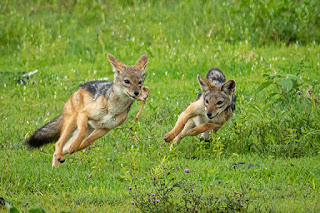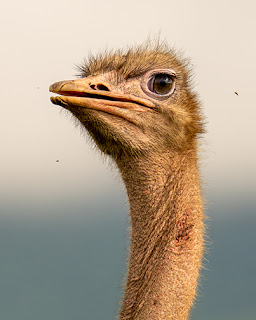Submitted by Sheila Reeves
Hot and tired from fending off a dozen hyenas and half that
many jackals from its buffalo kill, the big male lion plopped down in the shade
created by our safari vehicle. Flies crawled over his face, congregating
especially in the corner of his eyes and nostrils. His heaving body was about
10 inches below the open window. There was a temptation to reach out and pet
him.
This is Tanzania!
After 23 hours of travel, we set out on an awesome adventure
with Steve Gettle Photography and Mazingira Safari Tours! (The day before the
trip, Steve Gettle’s father died. He and Nicole Suddeth joined us for the last 4 days of the safari.)
There were eight photographers in three vehicles. In
addition to the windows, the entire top of the safari vehicles lifted up about
2.5 feet, so that cameras could shoot above the vegetation.
After several hours of sleep at Rivertrees Lodge, we had
breakfast and departed for Tarangire National Park. Tarangire is known for its
large herds of elephants as well as the variety of plains animals and birds. It
did not disappoint! On the first game drive we saw elephants, giraffes, a
leopard, a dik-dik, impalas, jackals, baboons, mongooses, monkeys and warthogs,
as well as lilac-breasted rollers, red-billed hornbills, yellow-billed
hornbills, magpie shrikes, fish eagles, Egyptian geese, Orange Bishops, Superb
Starlings and more!
We spent most of two days in the field before checking in
at the Tarangire Sopa Lodge (elevation:5000 feet). We caught our first glimpse
of Hippos, as well as impalas, waterbucks and Thompson’s Gazelles (Tommies).
Then, we headed out for another morning game drive in
Tarangire National Park before driving along the wonderful scenic route to
Ngorongoro Crater. It was a very muddy, rainy, scary drive!
We arrived at Ngorongoro Sopa Lodge (elevation: 7000 ft),
our home for the next three nights. The next morning, we descended 2000 feet
into the crater for an all-day game drive. We saw a wide variety of wildlife
that call the crater home: lions, zebras, elephants, gazelles, wildebeests,
warthogs, hyenas, cape buffalo, jackals, and an abundance of bird species. The
crater is actually a caldera formed when the volcano
collapsed.
Then, we headed for the Serengeti,
enjoying a game drive along the way to the Ndutu Safari Lodge (elevation: 5300
ft). We would call this lodge home for four nights.
In the Serengeti, we were able to go off
road! We left before sunrise on Friday, January 31st and enjoyed a
safari breakfast in the bush. We spent three long days exploring this area. One
of the highlights was having a meal in the field surrounded by thousands of
wildebeests and zebras. The animals did not come close when we were out of the
vehicles, but every direction we looked, they lined the horizon. Another
highlight was coming upon a newborn wildebeest. Our drivers/guides told us it
was probably just an hour or two old. When we first stopped to observe, the
baby was standing on wobbly legs, but in a few minutes, it was walking, and a
few minutes later, it was running. The babies need to be able to keep up with
the herd within hours of birth.


We left Ndutu, and enjoyed another game
drive as we travelled to the Ngorongoro Farm House, where we arrived for lunch.
It was pouring down rain when we arrived. January and February are supposed to
be the dry season in this part of Tanzania. But this year, it had rained at
least a little EVERY day since October. There has not been a dry season. The
only day of our trip with no rain was the day we left.
On our last day in Africa, we packed up
for our return home. We drove to Arusha where we had a leisurely lunch at
Jacob’s home, prepared by his wife. After lunch, we spent a few hours at the
Cultural Heritage Centre in Arusha before heading to the airport for a very
long journey home!
The lodges were all very nice. We had plenty of food. The
driver/guides were competent and extremely knowledgeable. We felt well
cared-for. We saw some amazing sights and took some really fun photographs. It
was a grand adventure!
And if electricity, hot water, and Wi-Fi were in limited
supply? Well, that is Africa!





















































